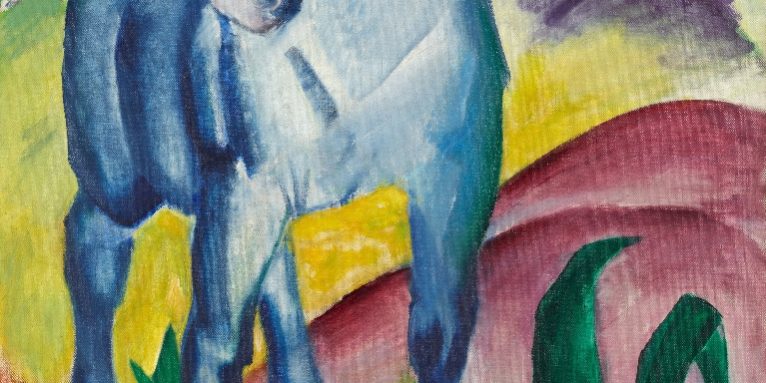Franz Marc (1880-1916) was a young man who spent much of his life at the crossroads of war and peace. Even though he would never return from the battlefields of World War I, a sense of peace echoed in his paintings. However, the serenity infused into his artwork did not come from the vibrant colors he used or the subject matter (mostly animals) he featured. His masterpieces had a place in the Expressionist movement because they revered the wisdom of artists who came before him and leveraged the collaboration of fellow artists from his era. But the first artist to influence the work of Franz Marc was his father, a landscape painter. To some, Franz Marc is one of the greatest animal painters of the 20th century.
However, the serenity infused into his artwork did not come from the vibrant colors he used or the subject matter (mostly animals) he featured. His masterpieces had a place in the Expressionist movement because they revered the wisdom of artists who came before him and leveraged the collaboration of fellow artists from his era.
Marc’s art was characterized by his use of bold and vibrant colors. In fact, by the age of 30, which was near the pinnacle of the young artist’s career, Marc had laid out a set of principles to guide his use of color. In a letter to artist August Macke, Marc wrote, “Blue is the male principle, astringent and spiritual. Yellow is the female principle, gentle, gay and spiritual. Red is matter, brutal and heavy and always the colour to be opposed and overcome by the other two.”
When looking at Marc’s work and reading his biographies, it becomes clear that he valued the wisdom of fellow artists. However, nothing proves this more than the “Der Blaue Reiter” almanac, which Franz Marc spearheaded in 1911. The title, which translates to “The Blue Rider,” represented a group of artists who rejected Neue Künstlervereinigung München, which was a strict form of art principles set forth by Wassily Kandinsky in 1909. The Blue Rider artists exhibited under this name until 1914.
In addition to color, Franz Marc was known for painting animals using distinct angles. He frequently featured animals in their natural habitats. Portraying members of the animal kingdom with bright color and sharp angles allowed Marc to enhance the emotion of the being and its setting.
Some translated titles of Franz Marc’s artwork include: Dog Lying in Snow; The Yellow Cow; Deer in the Woods; Tiger; The Lamb; and Fate of the Animals. Actually, Fate of the Animals is known throughout Germany as Tierschicksale. This piece is arguably one of Marc’s most profound works of art. Today, it is displayed at the Kunstmuseum Basel in Germany, where, on the back of the canvas these words appear: “Und Alles Sein ist flamed Leid” (“And all being is flaming agony”). He painted Tierschicksale in 1913. Shortly after, Marc volunteered to serve the German forces in World War I. While in service, he explained the painting in a letter to his wife, saying, “it is like a premonition of this war –horrible and shattering. I can hardly conceive that I painted it.”
The concept of war pressed heavily on Franz Marc’s soul. He was distraught by the realities of World War I but still volunteered to fight. In the end, he never returned home. Franz Marc died at the young age of 36.
Despite his short life and abbreviated career, Marc influenced the world of art and advanced the Expressionist art movement. To this day his art is appreciated for its uplifting, emotional value. Even though it was painted in the midst of a dark era, the work of Franz Marc continues to master the art of tranquility. To some, Franz Marc is one of the greatest animal painters of the 20th century.
However, this post is meant to recognize his artist style and some major pieces. For those who want to read more of Marc ‘s story, visit this link: https://www.segmation.com/products_pc_patternset_contents.asp?set=FZM . Also, Segmation is proud to offer 31 digital Marc patterns. By downloading these paint by numbers masterpieces, you can emulate one of the most fascinating artists who ever lived.
Enjoy the 31 Franz Marc – German Expressionist Painter. Segmation has for you and continue to learn and celebrate the life of a great artist.
Read more Segmation blog posts about other great artists:
Jan Gossaert – A Great Flemish Painter of Antiquity”
Émile Bernard – Making Ideas Art
Alfred Stevens – A Life Immersed in Art
Sources:
Be a Artist in 2 minutes with Segmation SegPlay® PC (see more details here)
Join us on SegPlay® Mobile iTunes now available for iPhone and iPad



